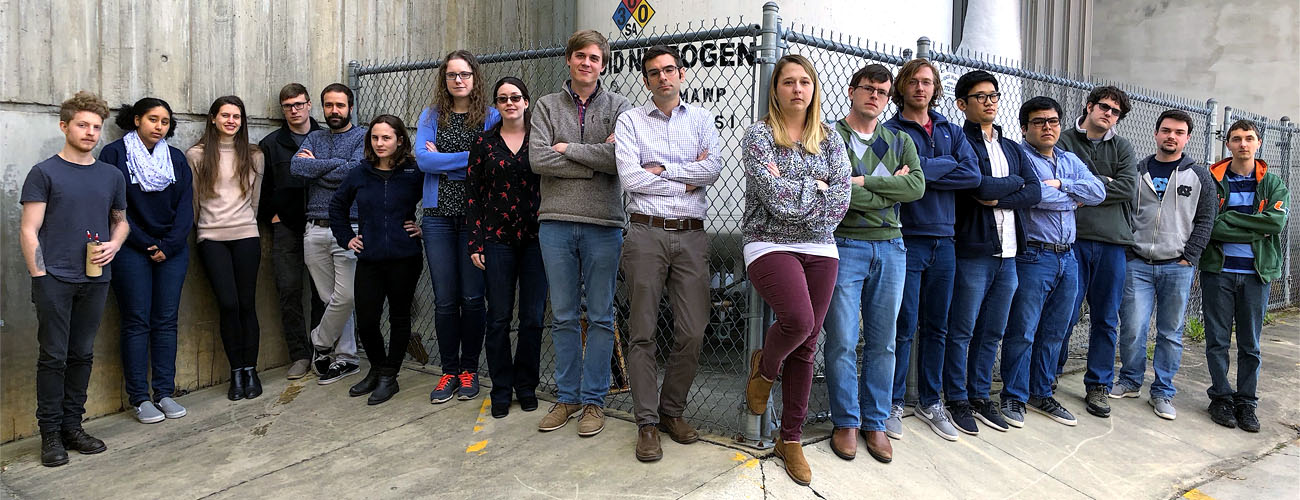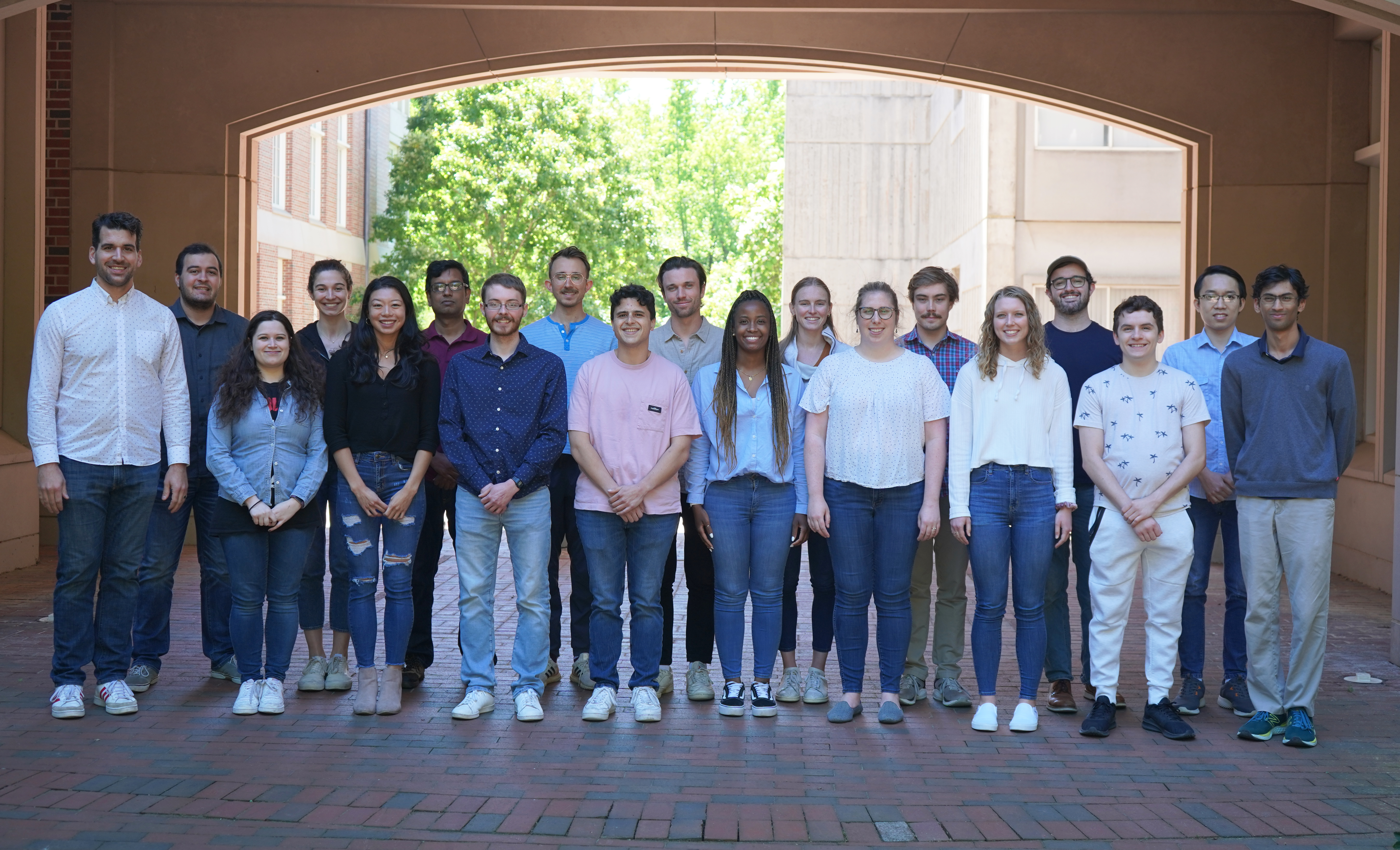Faculty Members

Andrew Moran
Professor
Caudill Laboratories 120919-962-0289
ammoran@email.unc.edu
Group Website
Curriculum Vitae
Research Interests
Spectroscopy and Dynamics in Condensed Phases; Nonlinear Optics
Research Synopsis
Knowledge of charge transport mechanisms informs the development of novel photovoltaic materials. For this reason, transient absorption spectroscopies are often conducted on isolated systems to characterize elementary energy and charge transfer processes. In these experiments, a “pump” laser pulse initiates charge transport and a “probe” laser pulse tracks the concentrations of photoexcited species as a function of time. Unfortunately, there is no guarantee that the species observed in such ex-situ experiments are functionally significant. For example, charge carriers that relax by emitting light do not contribute to the electric current produced by a device but can still be observed by transient absorption spectroscopy. Our group has developed time-resolved photocurrent spectroscopies to eliminate the ambiguities associated with conventional transient absorption methods. We apply a sequence of laser pulses to a photovoltaic cell and measure the nonlinear response of the photocurrent. Charge carrier trajectories are determined by varying the wavelengths of the laser pulses in addition to the times at which they arrive at the device. With this approach, charge carrier mobilities can be decomposed into contributions from specific paths taken through the active layer of a photovoltaic cell. Our newly developed techniques provide fundamental insights into carrier transport mechanisms and establish practical metrics of device performance. These methods are now being applied to photovoltaic devices based on semiconductors and polymers.
Professional Background
B.S. Chemistry, University of Nebraska at Omaha, 1999; Ph.D., Physical Chemistry, Kansas State University, 2002; Postdoctoral Fellow, University of Rochester, 2002-2003; Postdoctoral Fellow, Northwestern University, 2003-2004; Postdoctoral Fellow, University of Chicago, 2004-2007; National Science Foundation CAREER Award, 2010-2015
News & Publications

This perspective reviews recent studies of non-covalent interactions involving the π systems of organic cations in low-dimensional OIHPs.
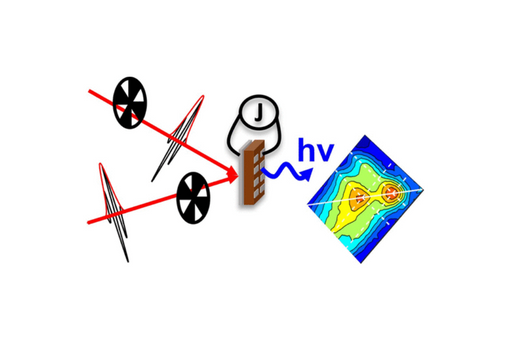
The class of action spectroscopies described in this Perspective leverages recombination-induced nonlinearities to distinguish lossy (fluorescence) and productive (photocurrent) processes within the active layers of photovoltaic cells.
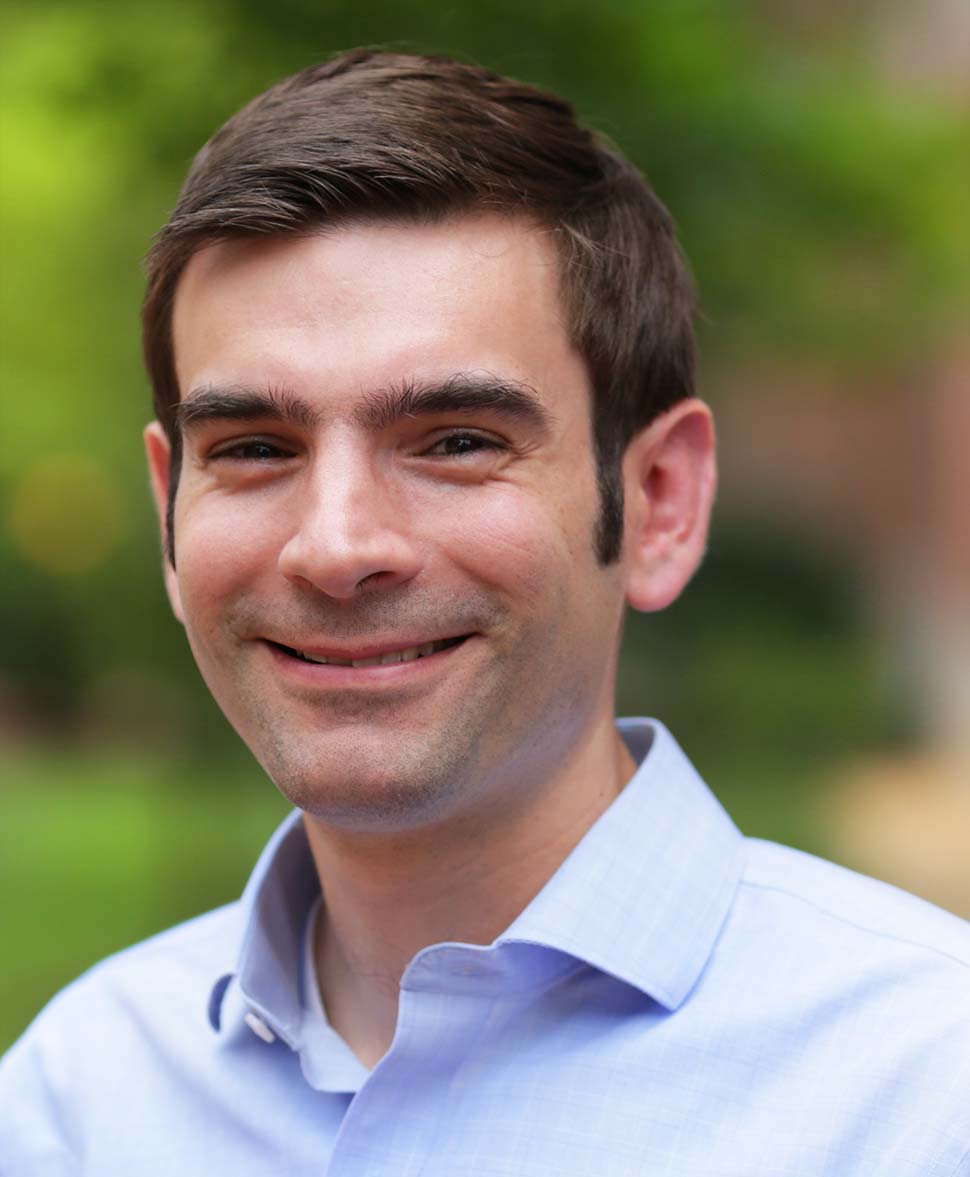
Alexander Miller
Professor, Director of Graduate Studies
Kenan Laboratories A400919-962-4618
ajmm@email.unc.edu
Group Website
Curriculum Vitae
Research Interests
Energy Catalysis, Synthetic Organometallic Chemistry, Metal-Ligand Cooperation
Research Synopsis
Research in the Miller group revolves around transformations relevant to global energy concerns, including the storage of solar energy in chemical fuels, proton-coupled electron transfer reactions, and hydrocarbon transformations. Our approach starts with the design and synthesis of transition metal catalysts, then shifts to examining catalyst performance with a focus on understanding reaction mechanism in order to inform catalyst improvements. Our catalysts feature multifunctional ligands: beyond simply supporting the metal center, the ligands position additional functionality in the secondary coordination sphere of the metal and work in concert with the metal center to enhance key steps in catalytic cycles.
Professional Background
University of Chicago, BS, 2005; California Institute of Technology, PhD, 2011; Dreyfus Environmental Chemistry Postdoctoral Fellow, University of Washington, Seattle, 2011-2012; James Moeser Award for Distinguished Research, University Research Council, 2014; NSF CAREER Award, 2016; Sloan Research Fellowship, 2016;
Research Group
News & Publications

This perspective reviews recent studies of non-covalent interactions involving the π systems of organic cations in low-dimensional OIHPs.

The class of action spectroscopies described in this Perspective leverages recombination-induced nonlinearities to distinguish lossy (fluorescence) and productive (photocurrent) processes within the active layers of photovoltaic cells.

Gerald Meyer
Professor
Murray Hall 2202F919-843-8313
gjmeyer@email.unc.edu
Group Website
Curriculum Vitae
Research Interests
Synthetic chemistry, Spectroscopy, and Electrochemistry
Research Synopsis
Transition metal compounds often possess low-lying excited states that can be populated with visible light. The nature of these excited states is of fundamental interest in their own right as is there subsequent reactivity. Particular emphasis on the excited states has focused on:
-
- Quantification of light driven inner-sphere reorganization that is novel to copper phenanthroline compounds by photoluminescence and, more directly, by x-ray spectroscopies. The x-ray characterization represents an ongoing collaboration with Lin Chen and her coworkers at the Advanced Photon Source, Argonne National Laboratory.
-
- Identifying the molecular origin(s) of the activational barriers for internal conversion of charge-transfer and ligand-field excited states in Ru polypyridyl compounds in fluid solution and at semiconductor interfaces.
-
- Prevention of the rapid light induced excited state spin trapping by the 5T state of spin-crossover Fe(II) benzimidazole compounds that occurs at TiO2 interfaces.
-
- Characterization of Co(I) compounds with low-lying metal-to-ligand charge transfer excited states.
- Dissociative excited states that release CO will be exploited to measure dioxygen activation by copper on short time scales. This research represents an ongoing collaboration with Ken Karlin and his coworkers at Johns Hopkins.
An excited state reaction of particular relevance to energy conversion in dye-sensitized solar cells is electron transfer to the unfilled acceptor states of TiO2 nanocrystallites. A fundamental goal is to optimize the efficiency of this reaction while at the same time preventing the unwanted charge recombination reaction. Specific goals include:
-
- Optimization of the relative rate constants for excited state injection and charge recombination by introduction of a conjugated bridge between a Ru polypyridyl compound and the surface anchoring groups. This research is done in collaboration with Elena Galoppini and her coworkers at Rutgers-Newark.
-
- Control of the excited state injection yield with potential determining cations and the excited state dipole orientation.
-
- Prevention of charge recombination by intramolecular electron transfer from a covalently bonded electron donor. Our most recent work in this area has been done in collaboration with Curtis Berlinguette and his coworkers at the University of British Columbia.
-
- Utilization of time resolved anisotropy measurements to quantify lateral intermolecular electron transfer reactions that occur after excited state injection.
- Quantification of the role surface electric fields play on interfacial electron and ion transfer chemistry as well as the non-Nernstian behavior of molecules at semiconductor interfaces.
Photocatalysis that stores solar energy in the form of covalent bonds in fuels is also of particular interest. In this regard, iodide oxidation continues to be the focus of much basic research as the electrons abstracted from iodide can be used to generate fuels from water or CO2. In future work, we will expand these studies to water oxidation through the UNC-EFRC. Specific emphasis will be placed on inventing new photo-chemistry where excited state electron transfer and chemical bond formation occur in one concerted step.
Professional Background
Ph.D., University of Wisconsin at Madison, 1989
B.S. State University of New York at Albany, 1985
Research Group
News & Publications

This perspective reviews recent studies of non-covalent interactions involving the π systems of organic cations in low-dimensional OIHPs.

The class of action spectroscopies described in this Perspective leverages recombination-induced nonlinearities to distinguish lossy (fluorescence) and productive (photocurrent) processes within the active layers of photovoltaic cells.

Simon Meek
Associate Professor
Venable Hall 1307919-962-0359
sjmeek@unc.edu
Group Website
Curriculum Vitae
Research Interests
Organic Synthesis, Organometallic Chemistry, Catalysis
Research Synopsis
Research in my group is involved with the discovery, design, and development of new chiral catalysts and catalytic methods for chemical synthesis. We focus on developing practical and effective catalysts that enable the use of simple and abundant starting materials for useful carbon-carbon and carbon- heteroatom bond forming reactions.
We are interested in understanding reaction mechanisms, efficiency and selectivity, as well as demonstrating and challenging our catalytic transformations, reliablility, in efficient enantioselective total synthesis of complex biologically important molecules. Areas of interest in my research program include catalysis, stereoselective organic synthesis, and organometallic chemistry.
Professional Background
M.Chem., University of Sheffield, 2003; Ph.D., University of Sheffield, 2006; Postdoctoral Fellow, Boston College, 2006-2011
News & Publications

This perspective reviews recent studies of non-covalent interactions involving the π systems of organic cations in low-dimensional OIHPs.

The class of action spectroscopies described in this Perspective leverages recombination-induced nonlinearities to distinguish lossy (fluorescence) and productive (photocurrent) processes within the active layers of photovoltaic cells.

Matthew Lockett
Associate Professor
Kenan Laboratories C348919-843-9440
mlockett@unc.edu
Group Website
Research Interests
3D Cell Culture Systems, Bioanalysis, Chemically Modified Electrodes, Microfabricated Devices, Surface Chemistry and Analysis, Sensors
Research Synopsis
We develop new analytical tools to study chemical phenomena occurring in complex biological and chemical systems—with a general focus on oxygen-regulated cellular signaling in tissues and electron transport at disordered interfaces on chemically modified electrodes. These models afford us exquisite experimental control, enabling structure-function relationships for small numbers of variables. We use these systems to build an overall understanding of the system through continued study, one hypothesis at a time. Our intellectual pursuits are not driven by a single measurement technique or approach but rather by adopting or adapting techniques that provide high sensitivity and accuracy. Some of the areas we are currently pursuing are:
3D Cell Culture Platform Development for Quantitative Studies of Hypoxia
Tissues and organs are three-dimensional structures composed of multiple cell types and extracellular matrices. These structures are spatially and temporally dynamic, with cells receiving regulatory cues from both abiotic factors and intracellular signaling molecules. Current methods of cell culture rely on monolayers of cells grown on plasticware. While these cultures are easily prepared and analyzed, they lack the realistic tissue architectures and physiologically relevant microenvironments found in vivo. These simplistic models often cannot predict cellular responses to drugs, environmental toxins, or other extracellular signals. We are preparing and characterizing new 3D culture platforms and measurement tools to meet these needs, focusing on tissue-representative microenvironments with materials and techniques readily accessible to any laboratory currently working with cells.
We are particularly interested in answering questions about oxygen's role in maintaining tissue homeostasis, directing cellular movement, and promoting aggressive and drug-resistant cancer phenotypes. In one approach, we construct thick tissue- or tumor-like structures by stacking layers of paper that contain cell-laden hydrogels. We can generate defined microenvironments with these paper-based cultures and relate oxygen tension to cellular responses to drugs or other external stimuli.
In Vitro Drug Metabolism and Models
There is a need for more predictive models of patient responses to drug therapies, particularly adverse drug-drug interactions. When placed in 3D culture environments, human hepatocytes (i.e., liver-specific cells responsible for drug metabolism) maintain their metabolic competency for more extended periods than when cultured as monolayers. An essential next step for 3D liver models is to engineer zonation into these cultures. Zonation is the spatial distribution of hepatocytes with defined metabolic functions along a blood vessel-like sinusoid. This organization of cellular function is responsible for multistep modifications of drugs as they move through the liver. Using the paper-based culture platform, microfluidic devices, and more traditional 3D culture setups, we generate liver-like environments and focus on identifying factors that promote and maintain zonation.
Quantifying Disorder on Chemically Modified Electrodes
Carbon materials have tunable electronic properties and unprecedented chemical stability, and thus, are ideal substrates for appending electroactive molecules or catalysts. The covalent attachment of molecules to carbon materials results in monolayers whose density may not be uniform and packing structures in which surface-bound molecules can readily adopt new orientations when perturbed. This disorder can lead to unexpected interactions and enhanced functionalities, observable with ensemble measurements. However, molecular-level details are challenging to pinpoint.
We are developing new attachment chemistries and measurement techniques to evaluate disorder on planar carbon electrodes. Our goal is to develop the design rules needed to leverage this innate disorder and impart desired physical or chemical properties of carbon and silicon materials through molecular engineering approaches.
Rationally Designed Surfaces for Improved Catalyst Stability and Performance
The chemistries required to modify the surface of carbon and silicon electrodes are often too harsh to append molecular catalysts to the surface directly. Instead, an initial layer of molecules with distinct chemical handles is attached to the surface, allowing for future installation of molecules through simple coupling chemistries. These chemistries provide a unique opportunity to tune the catalyst and electrode's chemical composition (e.g., its overall hydrophobicity, charge state, or ability to participate in hydrogen bonding). We develop methods to prepare arrays of chemically modified electrodes in an addressable and defined manner. This approach allows us to screen the impact of surface chemistry on catalyst performance and durability.
Professional Background
University of Pittsburgh, BS in Chemistry, 2005; University of Wisconsin-Madison, Ph.D. in Chemistry with Lloyd M. Smith, 2009; Harvard University, Postdoctoral Fellow with George M. Whitesides, 2010-2013
News & Publications

This perspective reviews recent studies of non-covalent interactions involving the π systems of organic cations in low-dimensional OIHPs.

The class of action spectroscopies described in this Perspective leverages recombination-induced nonlinearities to distinguish lossy (fluorescence) and productive (photocurrent) processes within the active layers of photovoltaic cells.
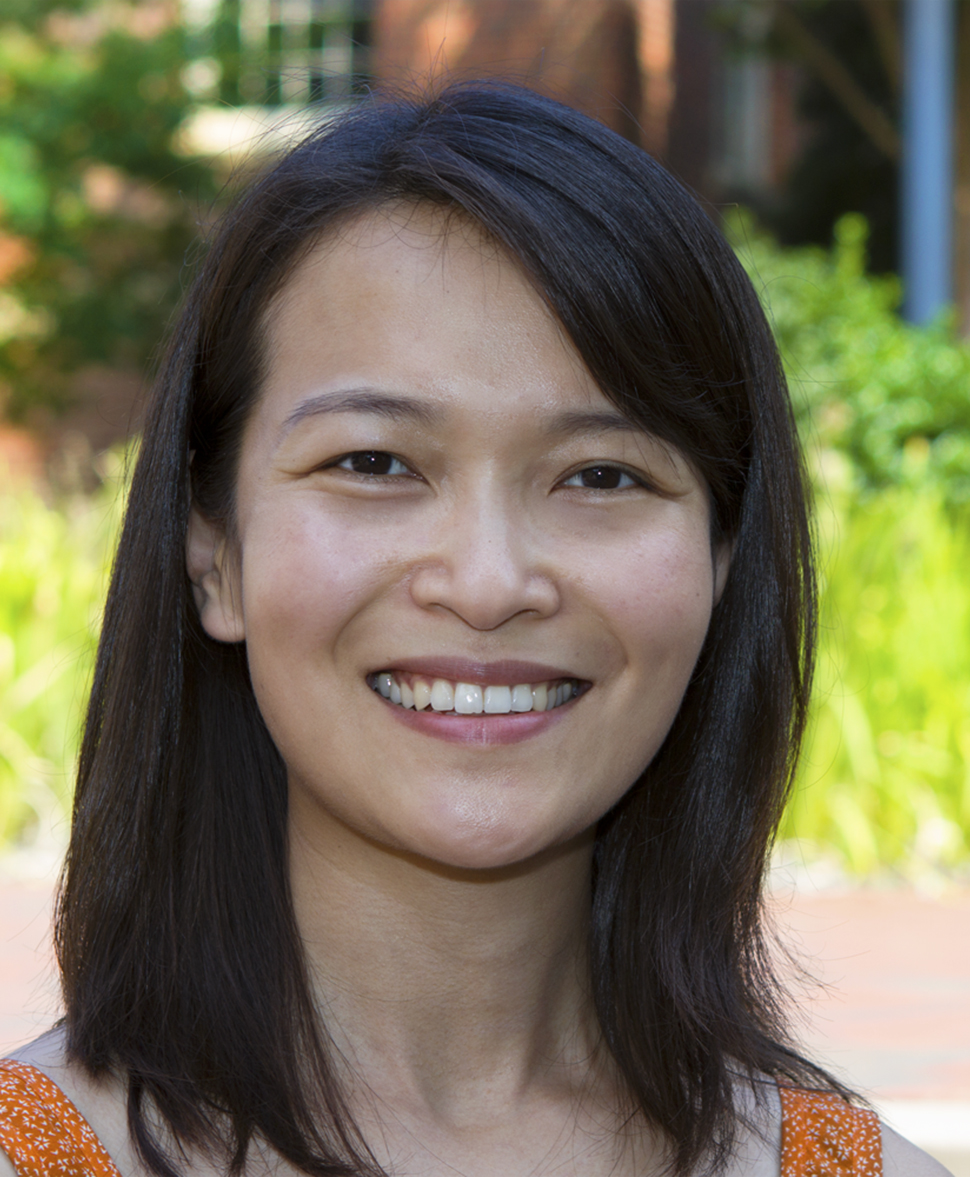
Bo Li
Professor
Genome Sciences Building 3256919-843-4436
boli@email.unc.edu
Group Website
Curriculum Vitae
Research Interests
Chemical Biology, Natural Product Biosynthesis and Discovery
Research Synopsis
Elucidating Antimicrobial Mode of Action.
More than half of all clinical antibiotics are natural products or the derivatives thereof. The Li group studies the antimicrobial mechanisms of underexplored classes of natural products and identifying synergistic combinations and conjugates of natural products in an effort to generate leads for next generation antibiotics that avoid or overcome resistance.
Deciphering the biosynthesis of antibiotics and antimetabolites.
Knowledge of biosynthetic chemistry is critical for efficient identification and engineering of natural products. The group’s research has focused on deciphering the biosynthetic pathways for natural products with unique structures and useful activities, including the antibiotic bicyclomycin and antimetabolite methoxyvinylglycine.
Identifying small molecules that enable or inhibit infectious disease.
Controlling and mitigating an infection requires a thorough understanding of how pathogens evade host defenses. The Li group is identifying small molecule virulence factors by mining the genomes of phytopathogens and studying their functions in plant infections.
Professional Background
Beijing University, B.S., 2004; The University of Illinois at Urbana-Champaign, Ph.D., 2009; Jane Coffin Child Memorial Fund Postdoctoral Fellow, Harvard Medical School, 2009-2013; National Institutes of Health Pathway to Independence Award, 2013; Rita Allen Foundation Scholars Award, 2016; Packard Fellowship for Science and Engineering, 2016; National Science Foundation CAREER award, 2016; NIH Director’s New Innovator Award, 2017
Research Group
Research in the Li group integrates chemical biology, enzyme chemistry, and microbiology to address challenges of antibiotic resistance and infectious disease.
Current projects include elucidating the mode of action of natural product antibiotics and identifying enzymatic reactions in natural product biosynthesis.
The group is also identifying bioactive small molecules made by microbes that live on and within eukaryotes to understand how these molecules contribute to the health and disease of their hosts.
News & Publications

This perspective reviews recent studies of non-covalent interactions involving the π systems of organic cations in low-dimensional OIHPs.

The class of action spectroscopies described in this Perspective leverages recombination-induced nonlinearities to distinguish lossy (fluorescence) and productive (photocurrent) processes within the active layers of photovoltaic cells.

Frank Leibfarth
Associate Professor
Caudill Laboratories 239919-962-3418
frankl@email.unc.edu
Group Website
Curriculum Vitae
Research Interests
Polymer science, organic synthesis, and continuous flow chemistry
Research Synopsis
Our research seeks to develop new methods for the synthesis of functional polymers with the goal of discovering and studying their emergent macromolecular behavior. The approach is rooted in the belief that the convergence of organic, continuous-flow, and polymer chemistries holds the key to making materials smarter, more functional, and more sustainable. The group is currently focused on developing methods to control stereochemistry in ionic polymerizations, uncovering enhanced function in commodity polymers through selective C–H functionalization, and creating automated approaches for the synthesis of unique polymer architectures with novel functions.
Professional Background
2022 – Present Associate Professor, Department of Chemistry, University of North Carolina at Chapel Hill 2016 – 2022 Assistant Professor, Department of Chemistry, University of North Carolina at Chapel Hill 2013 – 2016 NSF Postdoctoral Fellow with Professor Timothy F. Jamison, Massachusetts Institute of Technology 2013 Ph.D. University of California Santa Barbara, Professor Craig J. Hawker 2008 B.A. in Chemistry and Physics, University of South Dakota
Honors and Awards
University of South Dakota Spring Commencement Speaker (2022)
Journal of Polymer Science Innovation Award, ACS PMSE Division (2022)
Thieme Chemistry Journal Award (2022)
UNC Winter Commencement Speaker (2021)
Named one of the “Brilliant 10” early career scientists by Popular Science (2021)
UNC Tanner Award for Excellence in Undergraduate Teaching (2021)
Fellow, ACS POLY Division (2021)
NIH Maximizing Investigators’ Research Award (MIRA R35) (2021)
Camille Dreyfus Teacher–Scholar Award (2020)
Sloan Research Fellowship in Chemistry (2020)
Cottrell Scholar Award (2020)
Herman F. Mark Young Scholar Award, ACS POLY division (2020)
Beckman Young Investigator (2019)
Named among “Talented 12” by Chemical & Engineering News (2019)
NSF CAREER Award (2019)
Army Research Office Young Investigator Program (2019)
PMSE Young Investigator Award (2019)
Air Force Office of Scientific Research Young Investigator Program (2018)
3M Non-tenured Faculty Award (2017)
Emerging Leader Award, University of South Dakota Alumni Association (2017)
Research Group
Our research program spans each stage from molecular design to material function and will provide students with a diverse and competitive skill set bridging organic and polymer synthesis, small molecule and macromolecule characterization, and applied studies in material science and biotechnology. The goals of the research are inherently interdisciplinary and students will routinely work collaboratively both within and outside of the group to accomplish their scientific and professional goals. We envision our research efforts providing new and potentially useful solutions to challenges in sustainability and human health.
News & Publications

This perspective reviews recent studies of non-covalent interactions involving the π systems of organic cations in low-dimensional OIHPs.

The class of action spectroscopies described in this Perspective leverages recombination-induced nonlinearities to distinguish lossy (fluorescence) and productive (photocurrent) processes within the active layers of photovoltaic cells.
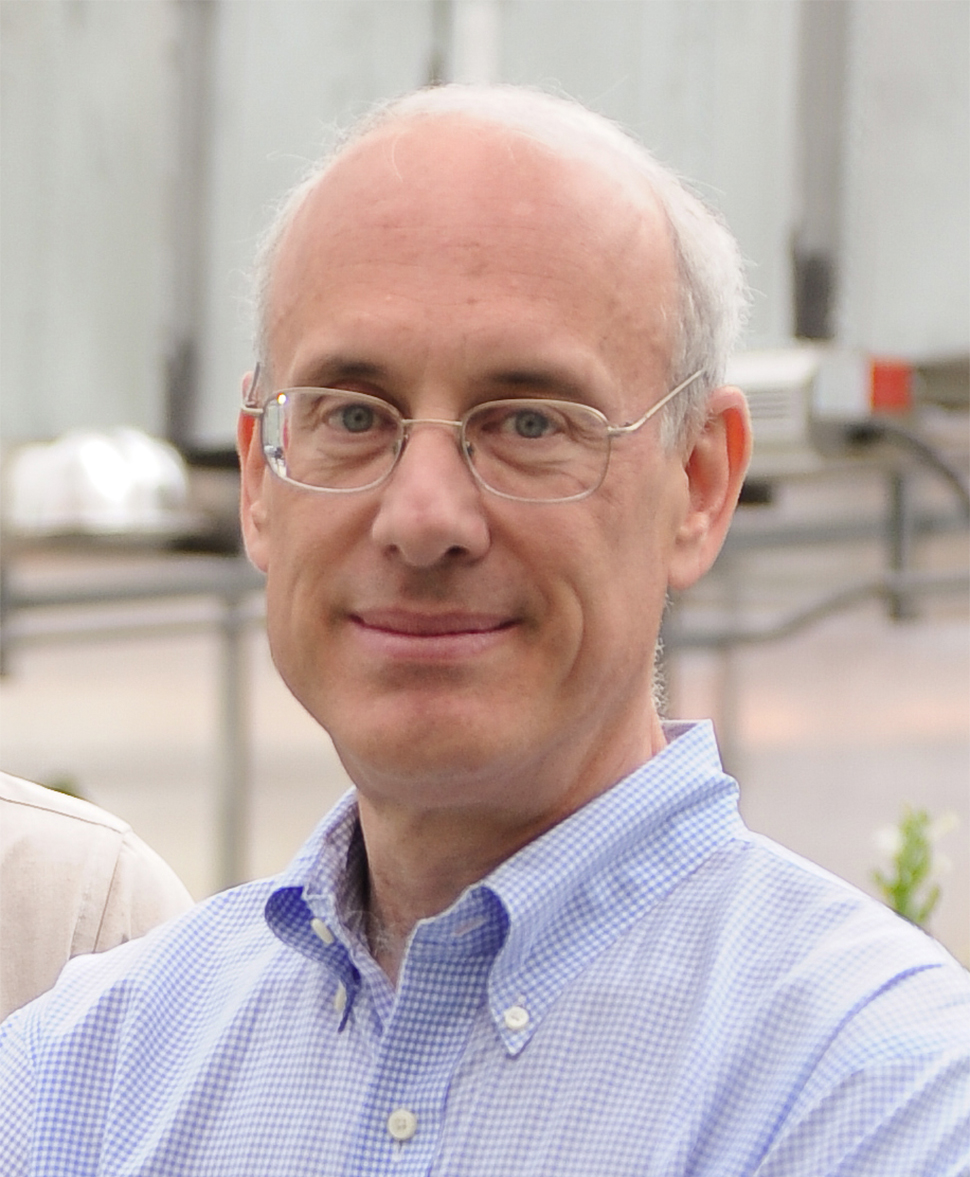
David Lawrence
Fred Eshelman Distinguished Professor, Jointly appointed with the UNC Schools of Pharmacy and Medicine
Kenan Laboratories A508919-962-8907
lawrencd@email.unc.edu
Group Website
Curriculum Vitae
Research Interests
Chemical Biology, Organic and Photochemistry, Molecular and Cell Biology
Research Synopsis
Living cells have been referred to as the test tubes of the 21st century. The creation of molecules that inhibit, probe, or alter the biochemistry of the cell lies at the nexus of chemistry and biology. The field of Chemical Biology seeks to correlate the underlying chemistry of life with the behavior of cells, tissues, and organisms. By revealing the nature of the molecular engine that drives cellular behavior Chemical Biology provides the molecular foundation upon which innovative therapies can be created for the entire spectrum of human afflictions.
The Lawrence research program is multifaceted, encompassing the fields of organic and peptide synthesis, photochemistry, enzymology, molecular and cell biology, and microscopy. This research team is engaged in the synthesis, characterization, and cell-based application of light-responsive agents, inhibitors, sensors, activators, proteins, and gene expression system, which are designed to manipulate and probe the biochemical pathways that control cell behavior. Disease states under investigation include cancer, neuropathologies, and inflammatory diseases.
Cellular Cyborgs
We have developed the cellular equivalent of cyborgs: Cells, erythrocytes, stem cells, containing implanted molecular devices, phototherapeutics. These tiny "terminators" are capable of launching multiple therapeutic agents at nearby diseased cells in response to wavelength-embedded commands. Since these light-triggered molecular launching pads detect red, far-red, and near IR deep-tissue penetrating light, they can receive external photo-instructions even when deeply embedded within tissue. In addition, the wavelength of light provoking drug launch can be pre-assigned, providing the ability to individually communicate with specific drugs in multi-drug carriers.
Angew. Chem. Intl. Ed. Engl., 2013, 52, 9936-9;
Angew. Chem. Intl. Ed. Engl., 2014, 53, 875-8;
Angew. Chem. Intl. Ed. Engl., 2014, 53, 10945 - 8.
Multicolor Monitoring of Enzyme Action
Conventional strategies for identifying the biochemical basis of tumorigenesis and metastasis rely upon the search for up-, or down-, regulated genes and proteins. However, the complexity and heterogeneity of many forms of cancer make it clear that this approach alone is not sufficient for extracting the information necessary to generate diagnostic and prognostic biomarkers. This biomedical imperative dictates the development of a series of new cellular and molecular strategies to tackle, what is admittedly, a devilishly difficult problem. We have developed an array of fluorescent sensors of protein remodeling enzymes, kinases, phosphatases, demininases, and proteases, that furnish robust readouts of catalytic activity, >100 fold, across the visible spectrum and into the near infrared. Furthermore, these sensors are photophysically distinct, enabling multiple enzymatic activities to be simultaneously monitored.
Angew. Chem. Intl. Ed. Engl., 2013, 52, 2323 - 5;
Angew. Chem. Intl. Ed. Engl., 2014, 53, 3975 - 8;
ACS Chem. Biol., 2015, 10, 433 - 40.
Light-Triggered Perturbation of Cell Behavior
We have employed a combination of organic photochemistry, organic and peptide synthesis, protein design, molecular biology, cell biology and microscopy to control and manipulate dynamic biological phenomena. Our molecular constructs have been used to identify the "steering wheel" of the cell during chemotaxis, with relevance to metastasis, probe intracellular enzymatic activity during the stages of cell division, reveal the mechanisms of gene transcription in single cells, and "command" cells to move or die upon exposure to a brief flash of light.
Science, 2004, 303, 743 - 6;
eLife, 2013, 2, E00750;
Angew. Chem. Intl. Ed. Engl., 2014, 53, 10904 - 7.
Predictive Personalized Pharmacology
The advent of effective pharmacologic inhibitors for clinical applications has created a critical need for assessing their efficacy in disease models and in patient samples. Biochemical analyses of aberrant signaling pathways are informative in terms of identifying the best treatment option and predicting therapeutic effectiveness in individual patients. One of the most compelling issues in preclinical and clinical drug discovery is the ability to accurately monitor drug action and patient responsiveness. In collaboration with Nancy Allbritton (Departments of Chemistry and Biomedical Engineering), and an array of clinician scientists on the UNC campus, we are developing chemical probes that can predict the optimal therapeutic agents for cancer patients.
PLoS One, 2012, 7, e48867;
Analytical Chemistry, 2013, 85, 6136 - 42;
Analytical Chemistry, 2014, 86, 4573 - 80.
Professional Background
UCLA Ph.D., 1982; NIH Postdoctoral Fellow, The Rockefeller University, 1982-85; Assistant, Associate, and Full Professor of Chemistry, SUNY Buffalo, 1985-95; Professor of Biochemistry, The Albert Einstein College of Medicine, 1996-2007; Professor of Chemistry, Chemical Biology & Medicinal Chemistry, School of Pharmacy, and Pharmacology, School of Medicine, Investigator, Lineberger Cancer Center, 2007–present; Chair, Division of Chemical Biology and Medicinal Chemistry, UNC Eshelman School of Pharmacy, 2011–present
News & Publications

This perspective reviews recent studies of non-covalent interactions involving the π systems of organic cations in low-dimensional OIHPs.

The class of action spectroscopies described in this Perspective leverages recombination-induced nonlinearities to distinguish lossy (fluorescence) and productive (photocurrent) processes within the active layers of photovoltaic cells.
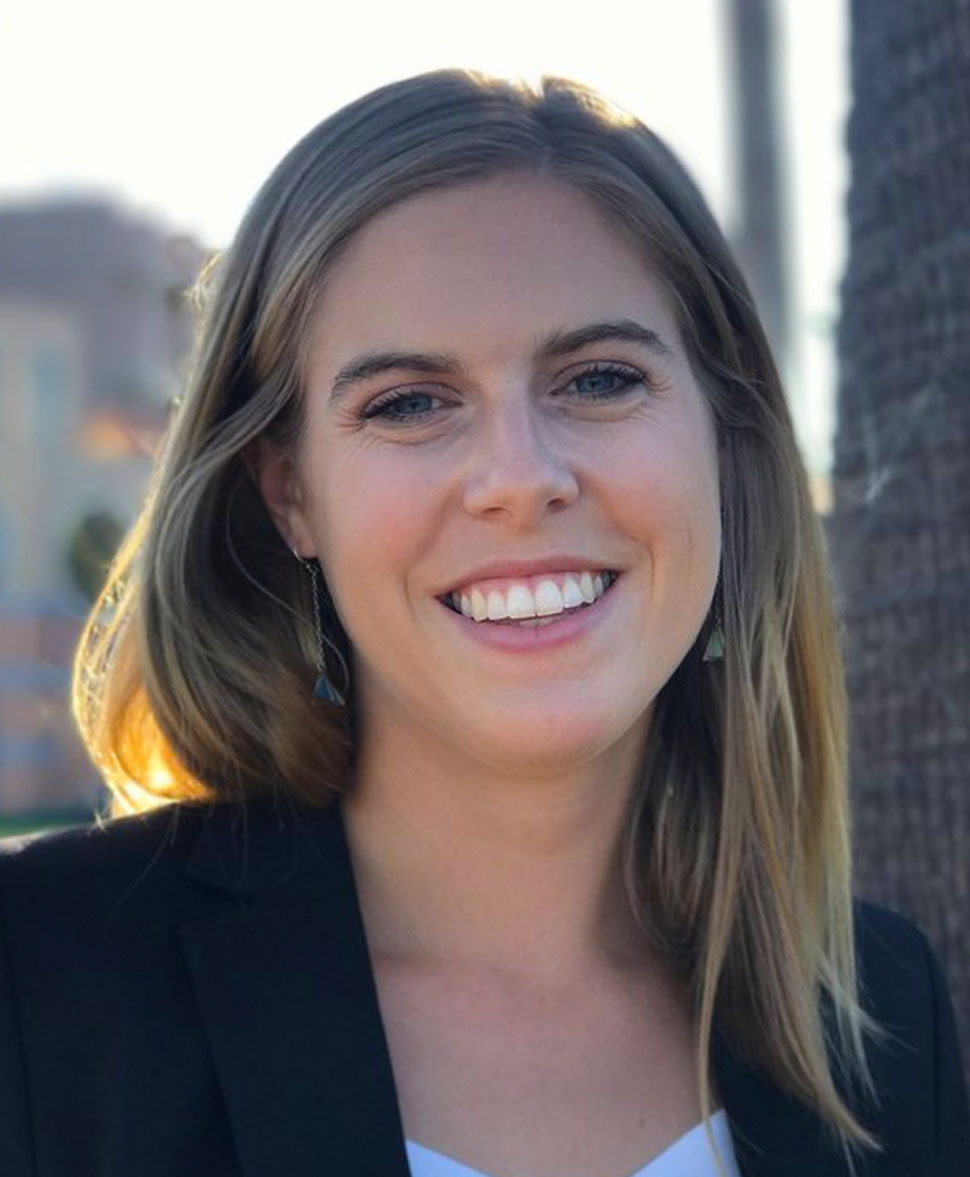
Abigail Knight
Assistant Professor
Caudill Laboratories 217919-445-1187
aknight@unc.edu
Group Website
Curriculum Vitae
Research Interests
Bioinspired Materials, Chemical Biology, Polymer Chemistry
Research Synopsis
The Knight group focuses on designing novel macromolecular materials with functions inspired by biological systems. These materials will generate platforms of new biomimetic polymeric architectures addressing growing concerns in treating, diagnosing, and preventing human disease.
This research bridges the fields of chemical biology and polymer chemistry using characterization and synthetic tools including polymer and solid-phase synthesis and nanomaterial characterization. Specific project areas include: (1) developing a new class of peptide-polymer amphiphiles inspired by metalloproteins, (2) designing well-defined polymer bioconjugates for biosensing, and (3) evolving functional biomimetic polymers.
Professional Background
B.S., University of North Carolina at Chapel Hill, 2010; Ph.D. with Professor Matthew Francis at University of California at Berkeley, 2015; Arnold O. Beckman Postdoctoral Fellow with Professor Craig Hawker, University of California Santa Barbara, 2015-2018
News & Publications

This perspective reviews recent studies of non-covalent interactions involving the π systems of organic cations in low-dimensional OIHPs.

The class of action spectroscopies described in this Perspective leverages recombination-induced nonlinearities to distinguish lossy (fluorescence) and productive (photocurrent) processes within the active layers of photovoltaic cells.

Yosuke Kanai
Professor
Caudill Laboratories 18919-962-3891
ykanai@unc.edu
Group Website
Curriculum Vitae
Research Interests
Theoretical/Computational Chemistry, Chemical and Material Physics, Condensed Matters, First-Principles Electronic Structure Theory
Research Synopsis
Developing a quantitative and predictive understanding of how novel dynamical phenomena emerge in materials and in other condensed phase systems from first-principles microscopic quantum theory is the central theme in our research. Research projects in the Kanai group are primarily in the field of first-principles electronic structure methods and their applications to condensed matter systems. We are particularly interested in the development and use of computational methods based on first-principles electronic structure theory for developing fundamental understandings in condensed matter chemistry and physics at the electronic and atomistic levels.
Professional Background
B.S., The University of Tennessee, Knoxville, 2001; Ph.D., Princeton University, 2006; BNNI Postdoctoral Scholar, The University of California, Berkeley, 2006-2009; Lawrence Fellow, Lawrence Livermore National Laboratory, 2009-2011
News & Publications

This perspective reviews recent studies of non-covalent interactions involving the π systems of organic cations in low-dimensional OIHPs.

The class of action spectroscopies described in this Perspective leverages recombination-induced nonlinearities to distinguish lossy (fluorescence) and productive (photocurrent) processes within the active layers of photovoltaic cells.


